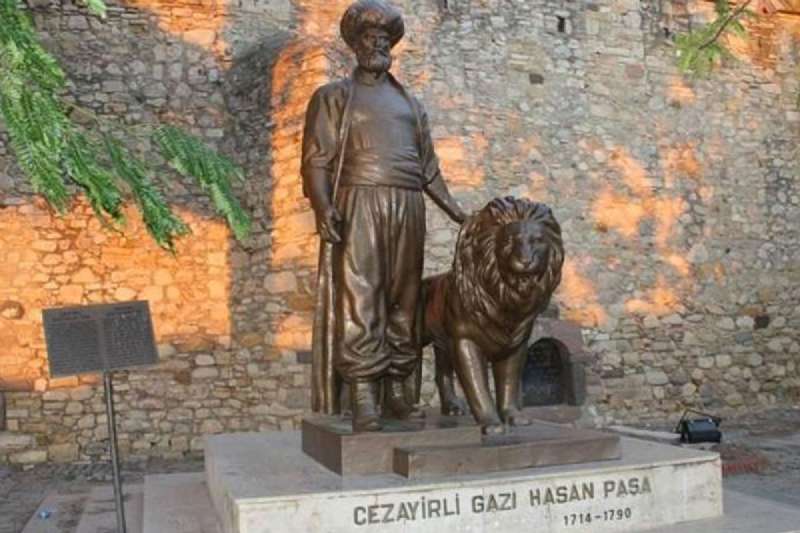Ottoman sailor carrying a lion with him: Who is The Gazi Hasan Pasha?
He is one of the grand viziers who served the Ottoman Empire and was known for his courage. Although he was nicknamed "Palabiyik" because of his majestic appearance, later on; He became famous with the titles of "Algeria" and "Gazi".

It is rumored that he was born in 1720 in Gallipoli. According to another narration, he was captured on the Iranian border at a young age, and later bought and brought up as a slave by a merchant from Tekirdağ. Hasan Pasha, who was later freed by his master, set out to go to Algeria, where he heard the fame of his valiants, with some capital given by him; however, on the way, when the ships ramped up to a foreign ship, Hasan Pasha, although he was very young, jumped to the enemy ship and joined the battle with great effort. When the ships separated with the change of wind direction, Hasan Pasha remained on the enemy ship, and after killing fifteen of the ship's crew alone, he captured the ship by locking the others in the ship's hold and cabin. However, since he was left alone with his bed in the middle of the sea, he was rescued by the Algerians and taken to Algeria. Since this courage of Hasan Pasha was highly appreciated by the Cezâyir Uncle at that time, the ship was left to him and he joined the uncles by giving him a coffee house. Reaching fame in a short time, Hasan Pasha, who became the chief of Tlemsen, was exposed to the envy of his uncles in Algeria and moved to Spain because his life was in danger. From there he came to Naples and from there to Istanbul.
Cezayirli Gazi Hasan Pasha or Hasan Pasha of Algiers (1713 – 19 March 1790) was an Ottoman Grand Admiral (Kapudan Pasha) (1770–90), Grand Vizier (1790), and general in the late 18th century. He is known to have been brought up as a Georgian slave in western Anatolia by a Turkish merchant of Tekirdağ, who raised him in that city considering him on a par with his own sons.
Since he was famous for his sailing, he was taken into the class of captains and given a ship. In 1770, he became a captain with the mîr-i miran rank and took Lemnos Island from the Christians, and earned the title of "Ghazi". Hasan Pasha, who became a vizier in the same year, was appointed as captain. Later, he became the Bosphorus guard, and then the Anatolian province and Rusçuk serasker. In the same year, he was declared captain for the second time. In 1780, the Vilayet of Morea was given to its administration as an addition. Hasan Pasha, who became the governor of the Grand Vizier in 1786, was dismissed from the captain-i-deryya position two years later and he was given the duty of serasker (commander in chief) of the Özi Castle.
In the first years when Hasan Pasha was the captain of the sea, the 1768 Turkish-Russian War broke out. The Baltic navy, which the Russians sent to the Mediterranean, saw reinforcements from the British navy and first fought with the Ottoman navy, but there was no definite result in this battle. In a second war fought in the vicinity of the Koyun Islands, close to the Aegean coast, the main battle was between Hasan Pasha's galleon and the Russian admiral Spiridov's ship. While the Russian ship was approaching his galleon, Hasan Pasha cut a few crucifixes. A few Turkish warriors clung to each rope and, together with Hasan Pasha, jumped on about thirty valiant Russian ships. Although Hasan Pasha received a gunshot wound during the heroic battle on the enemy ship, after fighting for a while without showing it, he managed to get on his own ship with his levents. Surprised by this unexpected raid, the Russians were alarmed and fired their own arsenal, and when the fire spread to the Turkish ship, both ships began to burn. When it became impossible to stay on the ship, Hasan Pasha took his bed in his mouth and jumped into the sea with his companions. Clinging to a piece of wood, they were rescued by a boat sent from the shore as they made their way towards the shore. Hasan Pasha was given the captaincy and governorship due to this heroism he showed.
Hasan Pasha's second-in-command ship lasted for 15 years. Hasan Pasha, who rendered great services during this time, suppressed the Tahir Omer revolt that broke out in Syria and Iraq; He defeated the rebellious Albanians in the Peloponnese, extinguished the fire of sedition, and restored peace and tranquility. Later, he participated in the Battle of Snake Island in the Russian-Austrian War of 1787 and defeated the Russian navy. He defeated the Russians in front of the Ismail Castle in November of the following year, and upon this success, he was given the title of grand vizier in 1789. Hasan Pasha's grand viziership lasted for three and a half months. He attained God's mercy in March 1790. He was buried in the lodge he had built in Shumen.
Hasan Pasha left many charitable works besides his state services. Hasan Pasha, who had barracks built for galleon workers in the Istanbul shipyard, had fountains built by bringing water to the city from a place four hours away from Middili. He had a fountain built in Bakla, a mosque and a bath and three fountains in Vize, a Pasha Mansion in the middle of Lesbos Island, a large marble pool, and fountains on the islands of Lemni, Chios, and Kos. His heroism was supreme. His îmân was strong and his administration was excellent. He would always take a lion that he had gotten used to walking around with him.
